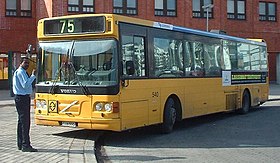
Back Volvo B10BLE Danish Volvo B10BLE German Volvo B10BLE Croatian Volvo B10BLE Dutch Volvo B10BLE NB Volvo B10BLE Polish Volvo B10BLE Russian Volvo B10BLE SIMPLE Volvo B10BLE Swedish 富豪B10BLE Chinese
| Volvo B10BLE | |
|---|---|
 Säffle 2000-bodied B10BLE in Finland | |
| Overview | |
| Manufacturer | Volvo |
| Production | 1993–2004 |
| Assembly | Sweden |
| Body and chassis | |
| Class | Bus chassis |
| Doors | 1, 2 or 3 |
| Floor type | Low entry |
| Related | Volvo B10B |
| Powertrain | |
| Engine | 9.6-litre horizontally rear-mounted I-6 Volvo THD103/THD104/DH10A (Diesel) Volvo THG103/GH10A/GH10B/GH10C (CNG/biogas) |
| Capacity | 30 to 45 seated |
| Dimensions | |
| Length | 12.0m, 13.7m and 14.5m |
| Width | 2500mm |
| Height | 3000mm |
| Chronology | |
| Successor | Volvo B7RLE Volvo B12BLE |
The Volvo B10BLE is a rear-engined low-entry single-decker bus chassis manufactured by Volvo in Sweden between 1993 and 2004. The first prototypes were built in 1992, but mass production started in 1993, only a year after the high-floor B10B. It was popular in Australia, Scandinavia and the United Kingdom. It had the engine mounted on the rear overhang of the bus. It became the successor of the city bus version of the B10B and was used as a base for single-decker buses worldwide. The B10BLE was available in diesel powered format, and later in a compressed natural gas powered format with the fuel tanks on the roof of the bus. Its low-floor design was widely promoted by Volvo when it was first launched, on the basis of added convenience to the passengers, and the increase in transport efficiency due to the low-floor design.
The production of the diesel powered variants ended in 2001 to give way for B7RLE and B12BLE, while the CNG variants were produced until 2004. In the United Kingdom market, Volvo unsuccessfully tried to replace the B10BLE with the B7L in 2001, but realised that it was not as popular among the customers and offered the B7RLE from 2003. This situation was similar to B10L one, which was replaced by B10BLE in 1997, three years after B10L was introduced here and also due to limited success.